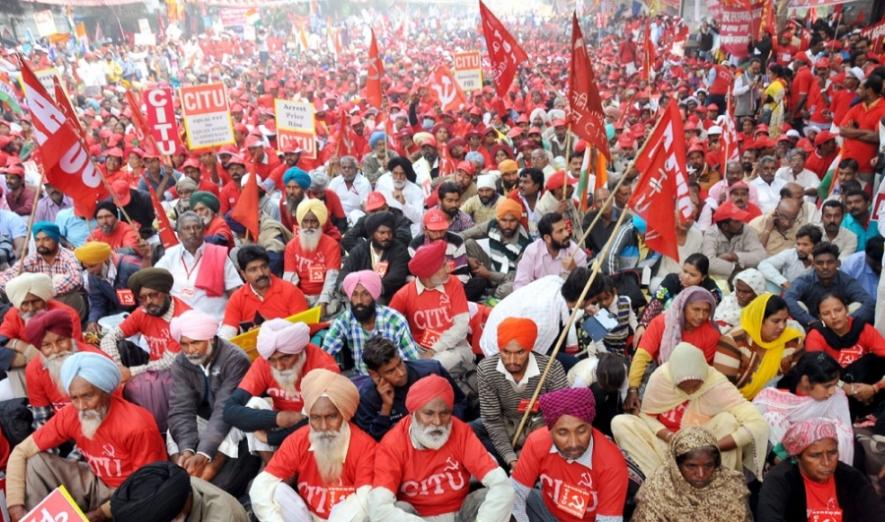5 Sept Workers-Peasants Rally: Ensure Jobs for All

Image Used For Representation Purpose Only
The biggest crisis facing Indian people today is the lack of decent jobs. Prime Minister Narendra Modi’s election promise of ensuring 1 crore jobs every year has turned out to be a hoax. Far from improving the jobs situation as compared to the decade of ‘jobless growth’ witnessed under the previous UPA regime, things have become worse.
Every year, some 12.4 million (1.24 crore) people join the army of job seekers every year. Since not enough jobs are available, every year, a major chunk of these people become either completely unemployed or start working at very low wages. Modi’s policies – stressing self-employment or foreign investment – have failed to create the jobs they were supposed to create, which is not surprising because these policies were short-sighted and not based on any justifiable grounds.
The tragic results are there for all to see. Under Modi’s first two years, over 10 lakh jobs were lost, according to a study by the Reserve Bank of India. Total number of people working in the country went down by 7.7 lakh in 2014-15, and further by 3.8 lakh in 2015-16. Then things went from bad to worse. Of all the 15 years and above people in the country, some 43% were working in 2016. By 2018, this share had fallen to 40%, according to CMIE. That means 1.43 crore working people had lost their jobs. Latest CMIE data shows that number of working people fell from 408.4 million in January 2017 to 397.5 million in July 2018, a loss of 10.9 million (just over one crore) jobs in just the last one and a half years. Meanwhile, women’s employment continues to languish with the 2016 Labour Bureau report saying that just 22% of women in the 15+ age group were working.
Unemployment has crossed 5% according to CMIE estimates. That is about 2 crore persons. In addition, it is estimated by the government’s Labour Bureau in 2016 that about 35% of the workforce is either not finding year-round work or is forced to work in very low paid casual work. That’s about 13 crore people.
Government that Kills Employment
The government and the public sector directly create only a small part of the total employment in India. Even here, the Modi govt. has failed since govt. jobs are declining. In 2014, employee strength in Central Government Establishments (Ministries, Railways, Postal Department, Police, etc.) was 33.28 lakh which dipped to 32.53 lakh in 2017, according to Union Budget documents. So, by 2017, about 75,000 government jobs had disappeared and the trend is still continuing.
In addition to this, there are also over 330 Central Public-Sector Enterprises (PSEs) which employed 16.91 lakh persons in 2014 – mainly in mining, steel, oil, heavy and medium engineering and fertilizer sectors. This has shrunk to 15.24 lakhs in 2017 – a loss of 1 lakh 67 thousand jobs. The greatest decline has happened in the non-executive category where skilled workers went down by 1.11 lakh and unskilled by 77,000. These were partially replaced by casual and contract workers whose numbers have gone up from 3.4 lakh in 2014 to 3.93 lakh in 2017, according to government figures. Thus, lesser and more irregular employment in PSEs has been one of the gifts of the Modi government to the nation!
Crisis of industry and Construction
Industrial and construction sectors have been the worst hit by job losses. In the first decade of the 21stcentury, construction sector grew at over 10% every year. In the four years of the BJP government, the average is under 4% per annum. As a result, jobs in this sector, which were taken up by distressed agricultural labourers, have shrunk dramatically.
Industrial growth has been poor throughout this decade and the BJP government has been able to do nothing to change it. The Index of Industrial Production (IIP) which measures industrial output growth has been up and down, dipping from 3.8% in 2014-15 to 2.8% in 2015-16 then inching up to 4.5% in 2017-18 on an average. With demonetisation and GST disrupting the economy further in the next two years, the problem has only worsened. These have hit the unorganised manufacturing most severely.
Modi’s job schemes have failed
Government Schemes like Skill India (Pradhan Mantri Kaushal Vikas Yojana), Make in India or Mudra Yojana have failed miserably to generate new job opportunities. Out of the 41.3 lakh people trained in three years under Skill India, just 6.15 lakhs or 15% got placed because there are no jobs available. The government claims that people are becoming self-employed giving figures of Mudra loans worth Rs. 4.6 lakh crores given to 10.38 crore people. That works out to a mere Rs. 44,000 per person. The PM and his ministers are claiming that all these loan-takers have not only become employed but have given jobs to others too. This sounds very improbable because there is no data to show that these loan-takers were earlier unemployed. And, can an enterprise run on the basis of Rs.44,000 investment. Perhaps some small shop or pakoda selling stall but definitely nothing more.
Data put out by the govt. on increase of 70 lakh formal sector jobs is also highly dubious. This estimate is based on enrollments in EPFO, ESI etc. which are social security schemes applicable mostly in the formal sector. New enrolments in no way indicate first time employment. In fact, many employers started offering the coverage to existing employees after the govt. announced that it would bear the cost of the employers’ contribution.
Jobs in agriculture
In India, traditionally agriculture has been a major source of employment – both self-employed as well as wage-work. However, with more and more peasants losing land and the increasing unviability of agriculture, more and more people have been driven out of agriculture and forced to seek work elsewhere. The BJP had promised to double farm incomes and increase the employment potential of the agricultural sector. In reality, farmers incomes have declined, rural wages are stagnating and in conditions of declining jobs more people are forced to join the army of unemployed.
The deepening agrarian crisis has implications not just for employment in agriculture but also that outside agriculture. As the number of job seekers increases, employers are able to keep wages low. Low wages and agrarian distress mean that working people cannot buy too much – thereby depressing demand in the economy which in turn hits job growth adversely. Joblessness decreases wages and brings down buying power. This leads to decline in production. So, more jobs are lost. This is the vicious cycle into which the BJP government has pushed the economy into!
The government thought that it would boost production and jobs by exports, through policies like Make in India. However, exports of non-oil products have been completely stagnant over the 4 years of the government – giving no boost to output and employment growth. On the other hand, imports, which compete with domestic production, have increased somewhat, destroying local industry and making more people jobless.
It is this devastating crisis of jobs that is one of the key issues being focussed upon in the forthcoming 5thSeptember rally. The working people are demanding reversal of these disastrous policies that benefit only the big corporates, domestic and foreign at the cost of the vast majority of the toiling people. It is to demand policies that generate decent employment for all those ready to work, particularly our youth.
[Based on campaign material prepared by CITU]
Get the latest reports & analysis with people's perspective on Protests, movements & deep analytical videos, discussions of the current affairs in your Telegram app. Subscribe to NewsClick's Telegram channel & get Real-Time updates on stories, as they get published on our website.
























